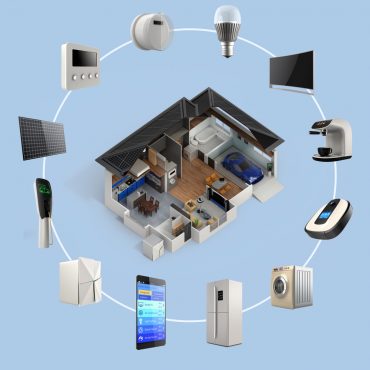
Many things going on in manufacturing right now such as the use of AI, augmented reality, and virtual reality can be enabled and aided by 5G.
The growing use of smart sensors and the Internet of Things (IoT) devices combined with more sophisticated analytics applied to the data they produce is driving a revolution in manufacturing. In many cases, the missing piece is connectivity.
Increasingly, 5G is seen as the wireless infrastructure element to bring these things together. It offers the required bandwidth, low latency, and reliability in harsh manufacturing environments. To get a better understanding of the role 5G can play in manufacturing, its challenges, and benefits, RTInsights sat down with Ricky Watts, Industrial Solutions Senior Director at Intel. Here is a summary of our conversation.
Why 5G in Manufacturing?
RTInsights: Why is there a need for 5G in manufacturing?
Watts: I’m going to break this answer down into a couple of areas. Let’s start with why is there a need for wireless in manufacturing? And then we’ll move it on to 5G.
Why the need for wireless in manufacturing? A lot of it’s driven by cost and flexibility. Typical manufacturing control systems in manufacturing environments are run over wireline and wireline protocols. But wireline is expensive to run. Bear in mind, you’re operating those wires in very harsh conditions often, so they’re usually triple insulated. There’s usually redundancy around those wires that are running. These things raise costs.
We’ve got a huge cost issue that exists inside the factories. How can I connect things up in a factory while reducing the cost, but still provide reliability? So, wireless itself becomes attractive. That’s where we start. Wireless becomes interesting to manufacturers because it allows them to connect things possibly cheaper. It also potentially allows them to connect things over a much wider area. And in the manufacturing areas, in some examples, we have expansive manufacturing plants. Take oil and gas manufacturing of petrochemicals. The plants have very large footprints. How do you cover that with wires when it’s difficult and expensive? You can use wireless.
So, let’s start there. Why is there a need for wireless in manufacturing? It comes down to cost, flexibility, ease of deployment, and other very useful things. And now, let’s look at what 5G does that other wireless technologies do not do.
Legacy wireless technologies are, in many respects, built around what I’d say is best effort. They have a connection between an endpoint and a receiver. That connection is made on what we would call some sort of best-effort scenario. And that could be free Wi-Fi, for example. If you’re on Wi-Fi at home, you connect, you move around the house, it kind of works, but it doesn’t necessarily work all the time. That isn’t very useful for some aspects of manufacturing. 5G starts to address the use cases and the requirements for industrial companies in the manufacturing environment. It helps with things like latency, reliability, performance, and bandwidth. These are fundamental requirements that exist in a factory have never really been dealt with before in the wireless domain.
If you took Wi-Fi or previous technologies to 5G, such as 4G, that we have today, it’s more of a best effort. Wi-Fi or 4G is not bad. They do a reasonable job, are useful in some environments, and many industrial companies use them. But 5G says, “Okay, now I’ve got a system that is going to be looking at some of the specific things that manufacturers are going to require such as latency, determinism, and time-sensitive networking.” 5G addresses all the use cases that exist inside the manufacturing environment. I get the benefits of wireline protocols, I get that reliable connectivity, and I now get that with a wireless technology that’s available to me called 5G.
That’s why we need 5G in manufacturing. 4G was about connecting people and connecting to the internet. 5G was designed with the aspect of connecting things, connecting things to things, and things to control systems.
5G Features and Technology Improvements
RTInsights: What features and technology improvements does 5G offer manufacturers?
Watts: Beyond the cost and flexibility advantages I mentioned, there are some other things to consider. We have a new 5G release from the 3rd Generation Partnership Project (3GPP), the industry organization that develops 5G specifications. The new release, Release 16, introduces many features. For example, it offers ultra-reliable low-latency communications (URLLC). Now I get determinism, over the air interface, and the connectivity that’s associated with it. That’s a very specific feature that says now I could run a motion control system. I could run real-time analytics over a camera, where I’m taking information off of a camera. I’m going to be able to do that reliably, and in a deterministic way.
Another feature that you get with 5G is massively increased bandwidth. You’re getting a much wider pipe to transmit data. That lets me carry more information. Manufacturing modernization and initiatives like Industrial 4.0 are all about using the data that’s in the factory and processing that data generated at the edge. With 5G, you can take a lot more data off the systems out there. I can install cameras and start to look at processes differently. Let’s say I’ve got a robot, for example, that’s doing some sort of welding process in a manufacturing environment. And I want to see, hey, is that welding process reliable? I now can start to look at the analysis of what’s going on at the weld point.
Having such data lets manufacturers do deeper analysis into their processes. For instance, with welding, there is a spark. Now I can start to analyze the spark. I can look at what’s going on at the electrical current end. And I can do all that analysis in real-time. If necessary, I can adjust something in the control system for that particular process to change it. So, I get quality control. Such real-time actions are only possible thanks to the bandwidth and low latency capabilities of 5G.
Another important capability of 5G is that, as is the case with Wi-Fi, a manufacturer can create a private on-premises 5G network. There are many ways that you can do that now. A private 5G network is very flexible for end-users and manufacturers. I can effectively have a wireless solution put on my factory floor that connects everything in that environment.
The advantage of a private network is that I can control the data. I can control what the network is connecting to. I can keep the data local. I can do it in what they call a hybrid fashion. I could work with the carrier to give me a part of the network. They call that network slicing within a 5G environment. I can take a piece of that network and wholly design it around what needs to be done in the factory. Why would you want to do that? One of the most important things in the manufacturing environment is Service Level Agreements (SLAs). I need to understand any process that’s running any data. Is the data bandwidth guaranteed? Is the latency guaranteed?
What 5G does with things such as network slicing and private networking is that it allows you to have much more control. You’re not handing over the control of connectivity to somebody else. You’re maintaining it in your environment.
Such key 5G features [high bandwidth, low latency, and private networking] are super advantageous to what’s been there before. There are many others. For example, 5G can support device-to-device connectivity. I could create a mesh network. I could have sensors or cameras around my plant and use 5G to transmit data between them. I also can have redundant paths, which gives me more redundancy and more reliability. Inherently, across the spectrum of capabilities, 5G allows manufacturers to be much more confident that when they use this technology in their factory environment. It’s going to assure them that the outputs they’re going to get will be much higher than they’ve previously experienced with any other wireless technologies.
Challenges of Integrating 5G Into Industrial Networks?
RTInsights: How hard (or easy) is it to add 5G into industrial networks?
Watts: Introducing any technology into industrial networks is not easy, for good reason. A good friend of mine and one of my mentors used to say, “In the factory environment, if things go wrong, things can go boom, and things can go bang.” So, introducing any new technology into the industrial environment is a challenge. You’ve got to make sure you’re doing it safely and at the right level. You’ve got to also make sure that you’re bringing your people along with it as well. Somebody has got to run the system and work with it. I would say this is one area where we have a lot of challenges to overcome. We’ve got to work with end-users and the supplier community on how we’re going to do this. That’s an education thing. You need to get end-users, companies, and system integrators up to speed on the aspects of how to integrate 5G.
That’s a work in progress across the industry. We also need to start introducing this technology in an area where it makes sense and where you can control it as you start to expand its use. For example, let’s look at data acquisition from a camera or a robot. The obvious answer is to introduce 5G technology when you’re bringing in some new capabilities into the factory. In that way, you can add 5G into the manufacturing environment in a very controlled way. You bring in the technology; you bring it in with a new system. You get that system up and running. You use that to train your people. You use it to understand the technology much better. And then what you would do is expand its use. It’s like grabbing a beachhead and then expanding from that beachhead.
You establish the credibility of using the technology. You gain knowledge, and you start to then move that across the industry environment. That is not an easy task, but it’s a task that I think manufacturers and the supplier community are very well equipped to deal with. From an Intel perspective, we’re trying to put technology packages around what we do to make it simple to consume. We optimize it and make sure it works end-to-end. When a manufacturer receives the technology, it is almost just a plugin. The device is at one end, and a manufacturer’s systems, applications, and services are at the other end. The 5G technology that sits in the middle almost becomes invisible to the manufacturer. And that’s on many other manufacturers and us to work and seamlessly bring that 5G solution in a way that reduces friction and reduces some of those issues as the technology is added to an industrial network.
How will 5G Revolutionize Manufacturing?
RTInsights: In what ways will 5G help revolutionize manufacturing?
Watts: There are so many things going on in manufacturing right now that can be enabled and aided by 5G. We’ve got edge compute, AI [artificial intelligence], AR [augmented reality], and VR [virtual reality]. All these technologies are appearing in manufacturing now. 5G acts like the glue that connects these things together. You need to bring connectivity to all these new capabilities that we’re getting in the manufacturing environment. Whether it’s AI, whether it’s virtual reality, whether it’s dealing with situations like COVID, for example, where we want remote workers to come in and interface to machines that are working in the factory, 5G provides the glue.
The other area where manufacturers are going to benefit is that leading telco industry companies, including Verizon, AT&T, T Mobile, and more, are rolling out 5G services and building out their 5G networks. So, you’ve already got a massive amount of infrastructure that’s being installed, not just in the U.S., but globally. That technology is growing at an incredible pace. And It is overlapping now with the industrial domain.
What that does is it allows 5G not only to proliferate from a technology perspective, but it also allows the cost to come down as well because you’re spreading that cost over a large area. Now, I’m going to get a truly wireless technology that enables me to take data and use it in real-time control systems and operational systems. And this lets us connect these things together at the edge of the network.
Given that 5G is going to be ubiquitously available across huge areas, the costs will come down. In my mind, you will see much more flexible manufacturing and a much faster establishment of its use in working factories.
Factory work today is like single monolithic areas, or environments, where a factory creates a widget. Think of that expanding over a much wider area when 5G enables you to move operations, control, and connectivity in so many different areas. Someone gave me a fine example recently. When a hurricane goes through the Gulf, one of the big challenges is you get flooding, the manufacturing sites go off the air. Well, a lot of that is reset in the infrastructure that’s out there in the factory. Using 5G and low latency, you can move that compute environment elsewhere and just have connectivity to the devices. You can almost have a factory remote from a factory, and 5G will give you that infrastructure and enable you to do it. It will revolutionize manufacturing. I also think we’ll see an increase towards autonomous ways of working at the factory.
We’ll also see new business models coming out and new ways of manufacturing. For example, a manufacturer used to build a car. It was a black car, and it was a Ford. You’ve got a black Ford, and that’s it. Now, people want to go online and personalize their order: I want a blue car, with white spots, with this and that option.
Meeting such new customer demands requires interconnection from an infrastructure perspective. You need to have logistics, assets, other systems in the manufacturing environment all connected. 5G is going to be the glue that connects all of that together. So, to me, 5G changes everything. It’s going to take time. We’re going to see this roll out over the next five or ten years. It’s not a quick transition. But once it gathers pace, I think it’s going to revolutionize just about everything in manufacturing.
Learn more about 5G and the journey to Industry 4.0 in Intel’s new eBook: 5G Increases Mobility and Flexibility on the Path to Industry 4.0.
Learn more about the technologies that are building the future of industry at the online Intel Industrial Summit 2020, September 23-24th. Register now






